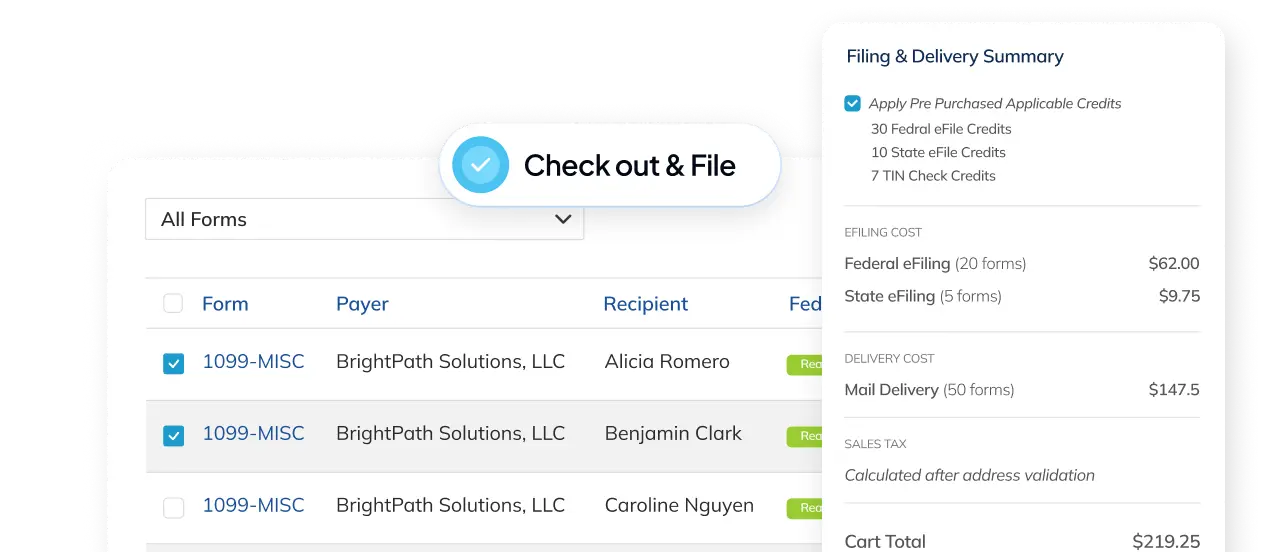W-2 vs 1099: Which Form Do You Need?

When tax season rolls around, choosing the right form is essential.
Two of the most common forms—W-2 and 1099-NEC—serve different purposes depending on how you pay workers. If you report certain types of miscellaneous income, the 1099-MISC may also come into play.
Here’s a quick guide to help you determine which forms you need to send, and what the key differences are between an employee and a contractor.
{{rich-card}}
What is a W-2 Form?
A W-2 form, officially known as the Wage and Tax Statement, is a document that employers must provide to each employee and file with the IRS and Social Security Administration. It reports the total wages paid to an employee during the year and the taxes withheld from those wages.
What the Payer Must Do:
- Withhold applicable taxes from employee wages, including:
• Federal income tax
• Social Security tax
• Medicare tax - Accurately complete Form W-2 for each employee, detailing wages paid and taxes withheld.
- Provide each employee with their W-2 by Monday, February 2, 2026, so they can file their personal income tax returns.
- Submit copies of the W-2 to both the IRS and the Social Security Administration by the same deadline.
- Use eFiling or mail to submit W-2 forms, depending on your filing method and volume.
- Maintain records of wages, tax withholdings, and filed forms for compliance and future reference.
What is a 1099-NEC Form?
The 1099-NEC* (Nonemployee Compensation) to report payments made to independent contractors or freelancers. If you paid $600 or more to a contractor during the year, you must issue a 1099-NEC.
*Note: Excess Golden Parachute Payments have moved from the 1099-MISC to box 3 of the 1099-NEC.
What the Payer Must Do:
- Track payments made to each independent contractor throughout the year.
- Determine if a Form 1099-NEC is required (generally if you paid a contractor $600 or more during the tax year).
- Complete Form 1099-NEC for each qualifying contractor, including accurate payment and identification details.
- Send the contractor their copy of Form 1099-NEC by Monday, February 2, 2026.
- File Form 1099-NEC with the IRS by the same deadline (February 2).
- Use eFiling or mail to submit the forms, depending on your filing method.
- Keep records of payments and filed forms for your own tax documentation and compliance.
What is a 1099-MISC Form?
If you made payments in these categories, you’ll need to issue a 1099-MISC.
What the Payer Must Do:
- Track payments made to non-employees for miscellaneous services, such as rent, prizes, awards, or legal fees.
- Determine if a Form 1099-MISC is required (typically if you paid $600 or more to a recipient during the tax year for qualifying expenses).
- Accurately complete Form 1099-MISC for each qualifying recipient, includingpayment details and taxpayer identification information.
- Send the recipient their copy of Form 1099-MISC by Monday, February 2, 2026, so they can report the income on their tax return.
- File Form 1099-MISC with the IRS by the same deadline (February 2).
- Use eFiling or mail to submit the forms, depending on your filing method.
- Keep records of payments and filed forms for your own tax documentation and compliance.

Which Form Do You Send?
Why It Matters
Issuing the correct form ensures:
Simplify Tax Season with Adams Tax Forms Helper
Adams Tax Forms Helper is an authorized eFile provider, making it easy to file your W-2, 1099-NEC, and 1099-MISC forms directly with the IRS and SSA: quickly, accurately, and securely.
Want to deliver forms digitally?
Our Email Delivery Service sends secure links to end-of-the-year tax forms to employees/recipients, ensuring timely and hassle-free delivery.
Whether you’re an employer, contractor, or small business owner, Adams Tax Forms Helper streamlines the process so you can focus on what matters.
Let’s get filing!
Employee vs Contractor: What’s the Difference?

Employees
Work under the direction and control of the employer. The employer dictates how, when, and where the work is done, and provides tools or training. Employers must withhold income taxes, Social Security, and Medicare, and issue a W-2 form annually.

Contractors
Operate independently. They control how they complete their work, often using their own tools and methods. Payers do not withhold taxes; instead, contractors handle their own tax obligations and receive a 1099-NEC form if paid $600 or more.
Why Choose Adams® Tax Forms Helper®?
No TCC Application
Save up to 45 days by skipping the wait for IRS processing.
Easy
to use
Save up to 45 days by skipping the wait for IRS processing.
Efficient andReliable
Save up to 45 days by skipping the wait for IRS processing.
Where to File
File your red ink Copy A of Form W-2 with a Form W-3 to the following address:
Social Security Administration Direct Operations CenterWilkes-Barre, PA 18769-0001 (for Certified Mail Use ZIP code 18769-0002)
File your W-2c (correction forms) and W-3c at the following address:
Social Security Administration Direct Operations CenterP.O. Box 3333 Wilkes-Barre, PA 18767-3333.
Lower eFile Limit
Reduce the 250-return threshold enacted in prior regulations to generally require electronic filing by filers of 10 or more returns in a calendar year. The final regulations also create several new regulations to require e-filing of certain returns and other documents not previously required to be e-filed.
Count All Returns
Require filers to aggregate almost all information return types covered by the regulation to determine whether a filer meets the 10-return threshold and is required to e-file their information returns. Earlier regulations applied the 250-return threshold separately to each type of information return covered by the regulations.
More Businesses Must eFIle
Eliminate the e-filing exception for income tax returns of corporations that report total assets under $10 million at the end of their taxable year, and require partnerships with more than 100 partners to e-file information returns, and they require partnerships required to file at least 10 returns of any type during the calendar year to e-file their partnership return.
Efficient andReliable
Corrections must be filed the same way the original was submitted. If you eFile the original then you must eFile the correction. If you mailed in the original then you must mail in the correction.
Do not cut or separate Copies A of the forms that are printed two or three to a sheet, except for Form W-2G. Generally, Forms 1097, 1098, 1099, 3921, 3922, and 5498 are printed two or three to an 8" x 11"sheet. Form 1096 is printed one to an 8" x 11" sheet.
These forms must be submitted to the IRS on the 8" x 11" sheet. If at least one form on the page is completed, you must submit the entire page. Forms W-2G are an exception and may be separated and submitted as single forms. Send your forms to the IRS in a flat mailing (not folded).
Do not staple, tear, or tape any of these forms. It will interfere with the IRS’s ability to scan the documents.
Pinfeed holes on the form are not acceptable. Pinfeed strips outside the 8" x 11" area must be removed before submission without tearing or ripping the form. Substitute forms prepared on continuous feed or strip form paper must be burst and stripped to conform to the size specified for a single sheet (8" x 11") before they are filed with the IRS.
Do not use a form to report information that is not properly reportable on that form. If you are unsure of where to report the data, call the information reporting customer service site at 1-866-455-7438 (toll free).
Do not submit anything other than red ink copies to the IRS.
Use the official forms or substitute forms that meet the specifications in Pub. 1179. If you submit substitute forms that do not meet the current specifications and that are not scannable, you may be subject to a penalty for each return for improper format. All of Adam’s tax forms meet the proper requirements, so use us as a resource.
Do not use dollar signs ($) (they are pre-printed on the forms), ampersands (&), asterisks (*), commas (,), or other special characters in money amount boxes.
Do not use apostrophes (’), asterisks (*), or other special characters on the payee name line.
No photocopies of any form are acceptable.
Do not print plain ink copies of your W-2 copy A or W-3 form. If a box doesn't apply to you, leave it empty.
Do not add "0".
Do not omit the decimal point and cents from entries.
Do not mistakenly check the “Retirement plan” checkbox in box 13. See page 22 of this IRS PDF for Retirement plan details.
Do not misformat the employee’s name in box e. Enter the employee’s first name and middle initial in the first box; his or her surname in the second box; and his or her suffix (such as “Jr.”) in the third box (optional).
Do not enter the incorrect employer identification number (EIN) or the employee’s SSN for the EIN.
Do not cut, fold or staple Copy A paper forms mailed to SSA.
Do not mail any copy other than Copy A of Form W2 to the SSA.
Correct Type 1 errors
File the correct form with the correct amount, code, checkbox, name or address, and check the “CORRECTED” box. This overwrites what you originally filed with the IRS under that person or company’s name and TIN. Send the corrected form to the recipient and prepare the red Copy A to send to the IRS with the Form 1096 transmittal if you’re paper filing. If you also had the wrong recipient/payee name or TIN do a Type 2 correction instead.
Correct Type 2 errors
For Type 2 errors, either the recipient/payee name and/or the TIN are wrong or you used the wrong form (like a 1099-MISC instead of a 1099-NEC). Action: This is a two-step process. First, you must zero out what you filed with the IRS under the wrong name/TIN and then file the new form.
Step 1
File a form with the CORRECTED box checked and the exact same payer and recipient information as on the incorrect form, but with all the amounts as zeros. This will remove the originally filed form from the IRS records.
Step 2
File a new Form 1099 with the right information as an originally filed form (not a corrected form).
Correct Type 3 errors
Incorrect Payer Name, Payer TIN, or both Action: Write a letter to the IRS.
If you filed with the wrong payer name (yours or your client’s name/company name) or the wrong payer taxpayer identification number (TIN), you don’t need to send in a corrected form.
Instead, you should write a letter containing the following information:
Name and address of the payer
Type of error (including the incorrect payer name/TIN that was reported)
Tax year Payer TIN Transmitter Control Code (if you eFiled),
Type of return, Number of payees, Filing method (paper or eFiling)
If you’re filing 10 or more information returns, STOP!
You have exceeded the IRS paper filing threshold and are required to file electronically.







